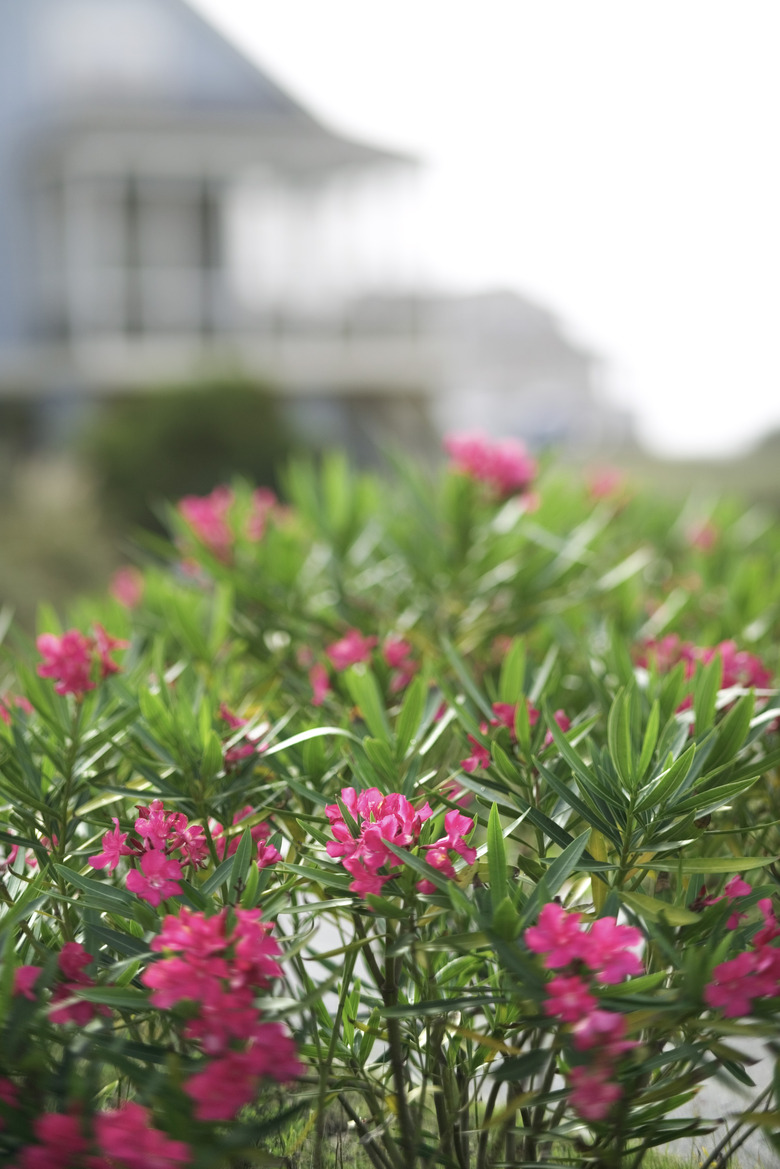Growing Oleanders In Eastern North Carolina
Summer visitors to the North Carolina coast may find themselves enchanted by drifting banks of blooming oleander (Nerium oleander) shrubs that are common in the region's landscapes. The city of Wilmington even named one of its main thoroughfares "Oleander Drive." These shrubs are low-maintenance garden plants that feature evergreen foliage, brightly colored blooms and a graceful habit. Where they can be grown across eastern North Carolina is limited only by the extent of winter freezes.
Step 1
Oleanders are hardy across U.S. Department of Agriculture plant hardiness zones 8 to 11. Members of the Nerium oleander species are native to the Mediterranean, Middle East and western Asia. They have been extensively hybridized and are grown widely across the southeastern U.S. They generally range in size from 6 to 12 feet tall and wide but may reach 20 feet tall in some instances. Dwarf cultivars are also available that only reach 3 feet tall and wide. Bloom colors include pink, coral, orange, red, white and yellow. Double-flowered forms are often highly fragrant.
Step 2
Step 3
- Oleanders are hardy across U.S. Department of Agriculture plant hardiness zones 8 to 11.
- They have been extensively hybridized and are grown widely across the southeastern U.S.
- They generally range in size from 6 to 12 feet tall and wide but may reach 20 feet tall in some instances.
Culture
Step 1
Oleanders prefer growing in full sun and will thrive in the summer heat of eastern North Carolina. They tolerate salty soils and drought, although supplemental waterings during dry periods in their first season will help ensure they become well-established. Plant oleanders in early spring or fall. They are not very fussy about soil pH or structure, but perform best in well-drained, sandy to loamy soils with low to moderate organic content. They can be left to their own devices or pruned for shape and structure. To maintain shape, prune oleanders lightly in early spring before flower buds appear and again in fall before winter dormancy. You can also prune overgrown or lanky oleanders fairly hard after the initial flowering period in early summer to rejuvenate them and control their size.
Step 2
- Oleanders prefer growing in full sun and will thrive in the summer heat of eastern North Carolina.
- They tolerate salty soils and drought, although supplemental waterings during dry periods in their first season will help ensure they become well-established.
North Carolina Ranges
Step 1
Oleanders are especially well-suited to North Carolina's coastal regions but can be grown as far west as Raleigh and north to Elizabeth City. The lowest winter temperature most oleanders will tolerate is 20 degrees Fahrenheit without serious damage or death. In the coldest regions of their range, they may freeze to ground level during winter but recover when temperatures warm in spring. If you live in a transitional, eastern North Carolina climate zone where occasional, deep winter freezes occur, mulch oleanders heavily in autumn to mitigate freeze damage to roots.
Precautions and Pests
Step 1
All parts of oleander plants are poisonous to some degree. Foraging animals can become ill if they ingest blooms or leaves. Pets and children should be kept from ingesting any plant parts. Some people are also sensitive to oleander sap, developing contact dermatitis after exposure. Do not burn oleander brush as the smoke can irritate respiratory passageways in sensitive individuals. Few pests are attracted to oleanders but some species of caterpillars, aphids and mealybugs will munch on the leaves and blooms. Damage from these pests is usually limited and minimal control measures may be necessary.
Step 2
- Oleanders are especially well-suited to North Carolina's coastal regions but can be grown as far west as Raleigh and north to Elizabeth City.
- If you live in a transitional, eastern North Carolina climate zone where occasional, deep winter freezes occur, mulch oleanders heavily in autumn to mitigate freeze damage to roots.
References
- National Gardening Association: Plant Care Guides: Oleander
- North Carolina State University: Shrubs: Nerium Oleander
- Google Maps: Oleander Drive, Wilmington, NC
- Clemson University: Oleander
- U.S. Department of Agriculture: Plant Hardiness Zones Map
- U.S. Department of Agriculture: Plants Profile: Nerium oleander
- Missouri Botanical Garden: Nerium oleander
